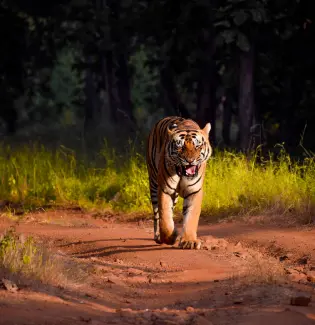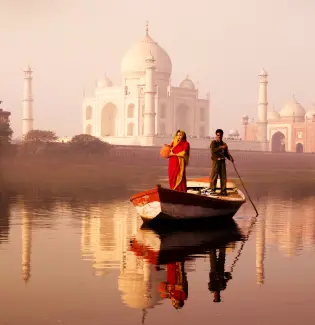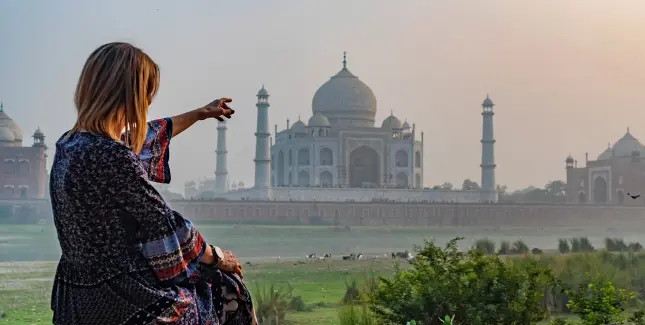Day By Day Itinerary
-
DAY 1
Delhi
This will be your arrival day at New Delhi International airport. Our representative who will meet you at the airport will introduce you to a traditional ‘Swagat’, assist you at the airport before taking you to a hotel for an overnight stay. While the booking in process is taking place, our representative will be introducing the tour to you and conclude by handing over the documents to you.

-
DAY 2
Delhi
Early morning, you can go for a walk through the majestic streets of Delhi. During this you are supporting another initiative known as Streetkids Project, supported by Memorable India, as you would be guided by one of the adult volunteer of Streetkids. This project is specifically intended to support the growth and development of street kids. The young volunteer is one among them and he gets his college tuition fees by guiding. As a Delhite he can help you to explore the city and its landmarks and would explain to you the importance of streets, buildings, monuments etc.
Later you can catch-up old Delhi with the Representative, who would help you to take a cycle rikshaw ride along the busy street, Jama Masjid, Chandhni Chowk local market and Sikh Temple.
Jama Masjid is the largest mosque in India, built by Shahjahan in 1657, with a courtyard which can accommodate 25,000 people and four minarets at each corners of the Masjid with 40 meters height would help you to have a panoramic view over the old Delhi. You can then proceed to Chandhni Chowk market to shop fine graded textiles and handicrafts. You are also visiting GurudwaraSisGanj to learn further about Sikh religion.
Next point is Qutub-Minar, a tall minaret which is built in 1199 by Qutab-ud-din Aibak, first Sultan of Delhi. The tall structure stands as an example of excellence of Indo-Persian architecture, which is also recognised as World Heritage Site by UNESCO.

-
DAY 3
Delhi - Varanasi
Morning, you leave for Varanasi by flight. The holy city could be a long cherished dream-cum-true for many. The city has a long history to tell you; about its culture, great conquers, what made the city very important, the cottage industry around it including handicrafts, the holy places and temples etc. Considering the devotees coming to the city from across the country and abroad it tries to give you a cosmopolitan culture by holding the tradition.
You would discuss with a scholar in the banks of Ganges about how culture and tradition prevailed in the banks of Ganges from the ancient period and what transformation happened over the years. You can also understand what changes the 19th century renaissance made in the traditions and rituals. Also you would come to know more about bhakti movement and spiritualism.
At evening you would go for a boat ride in Ganges to see sunset and how Hindu pilgrims come to ghats and perform pooja and other rituals to ensure salvation for their ancestors and perform prayers. Also you can perform aarti ceremony and enjoy candle and flower ceremony along with tabla and sitar playing. The boat journey is for almost 2 hours

-
DAY 4
Varanasi - Sarnath
You get-up early morning and go for a boat ride in Ganges to see the sunrise and how people perform morning rituals. You would find a great atmosphere filled with prayers and may turn your mind filled with joy and peace. Also you would admire people performing rituals with great devotion in the early morning.
Now you do have your breakfast at Open Hand, a vocational training cafe. Memorable India has partnered with Open Hand to give handful employment opportunities to the deprived people of the society.
In fact Open Hand is a social organisation, which is working on providing education, training and opportunities to the downtrodden of the society. Being the sole purpose of up-lift of the weaker section of the society, it works on every possible opportunity it can make use. Being a firm, which has great commitmentto the society and by understanding what a better society can deliver, Memorable India has decided to join hands with them with a single focus of making them par with the society in terms of training and opportunities. Please be informed that the social platform is helping them to make handicrafts and Memorable India helping them to sell it through Memorable India online gear shop.
Next you are planned to visit Sarnath. You would travel by road from Varanasi, which takes 2 hours by private vehicle. You would have heard about this city as, where Budha was giving his first sermon. It is believed that immediately after attaining enlightenment at Bodh Gaya, he travelled to here and was delivering it. He went a deer park and preached his discourse about the ‘Wheels of Dharma’. Buddhists are considering this as a holy place.

-
DAY 5
Varanasi - Khajuraho
You fly to Khajuraho, which takes almost 1 hour journey, to see the temples and its sculptures.
A major destination considering the importance of the sculptures and what it explains about the social life of the ancient period. Originally it was group of 85 temples and when it found in 20th century the number had reduced to 20. The temples are believed to be built by Chandela dynasty between 950 and 1050 has both Hindu and Jain temples. It is demarcated as a world heritage site by UNESCO, owing to its importance in terms of sculptures, statues etc., especially the Kamasuthra sculptures, which is intended to educate people about private life through erotic sculptures. Please keep in mind that these sculptures are showing the importance and excellence ancient Indian art.
You would be facilitated to get yoga class; yoga is considered to be purifying the mind and brings significant changes in mind and body. Do you feel that you got relaxed after the yoga session?
Our next destination is Agra.
You would travel by private vehicle toward Jhansi from Khajuraho which may take 4 hours. Then you proceed to Agra by train which is another 3 hours. If you haven’t experienced the train journey before, this would be a chance to mingle with local people and to understand more about them including their culture.

-
DAY 6
Agra - Ranthambore National Park
You are proceeding to see one of the seven wonders in the earth, The Taj Mahal; also you see Red Fort and Ranthambore National Park along with it with the help of a guide.
Taj Mahal, built by Shah Jahan in 17th century to commemorate his beloved wife, Mumtaz Mahal. The Mausoleum is built in ivory-marble along the south banks of Yamuna River in Agra. The architecture icon assumed to be attracting a lot of travellers to its shores. It is estimated that more than 70% of the tourists to North India is considered to be mainly to visit Taj Mahal. It is considered as the best in class of Mughal architecture and it is believed that it took almost 20 years to complete this mammoth building. You would find the reflective tiles, marble jali lattice, calligraphy on the walls, plant montifs etc., make the structure more attractive.
Agra Fort reconstructed by Shah Jahan, though it was built originally built in 11th century. It is made up of mostly using red sandstones, making the fort almost red in colour. The fort has emperor palace, meeting places, durbar etc. The fort is also listed in World Heritage Site list of UNESCO and was the imperial residence of Mughal Dynasty.
Now you are heading to Ranthambore National Park by private vehicle, which takes a 5 hour journey from Agra.

-
DAY 7
Ranthambore National Park
The day starting with a morning safari through the national park. Do you know that it was declared as project a tiger park in 1973? Hopefully you can look for tigers while you pass through the park. You can also see leopards, deers, different types of birds, nilgai, wild boar etc.
At the centre of the park has a fort named Ranthambore fort. The fort can give a view of the entire park as it stands in an uplifted plain. It is believed that the fort was built in 10th century and it has 3 stone temples devoted to Ganesh, Shiva and Ramlalji. The Ganesh temple is the most famous among them and you can find many devotees there, though inside forest.
The park was the major hunting spot of Jaipur Kings and you can find hunting lodges, pathway etc., gives a heritage atmosphere to the park.
You would be going through another safari in the park afternoon to watch and understand the wildlife in a close point of view.

-
DAY 8
Ranthambore National Park - Jaipur
After having the breakfast from Ranthambore, we are heading towards Jaipur, the city known for Palaces and also known as Pink city.
The travel would be arranged in a private vehichle; you can sit, relax and watch the sand dunes and pastures of Rajasthan. The journey would take 5-6 hours depends on the journey.

-
DAY 9
Jaipur
Plan for the day is to visit City Palace, Amber Fort, JantarMantar and Hawa Mahal. Also you can improve your cooking skills by attending a cooking class and a local market visit would fulfil your day.
Amber fort, which is also known as Amer fort is located on a hill, was built by Raja Man Sing 1 in 16th century. The fort has unique artistic style with blend of Hindu- Rajput architecture.
City Palace is a complex ofpalaces namely Chandra Mahal, Mubarak Mahal, Mukut Mahal, Maharani’s Palace etc., and built by Sawai Jai Sing II in 1732. The complex has many small palaces, gardens, pavilions and temples, and was builtwith the fusion of Indo, Islamic and Europian style architecture. It also has a museum, which would give you the information about the rich royal clothing and ornaments.
JantarMantar can be considered as an old planetarium cum observatory, which helped people to accurately measure the time during day time. It is a structure which helps the people to find time by the shadow of the central pillar. Also it has collection of old astronomical instruments which used by people in the 18th century.
You can visit the local vegetable market with a local family and you can learn cooking with the help of the family. They would teach you technics of preparing different dishes and how to make them delicious. You can also have dinner with them to understand more about cooking and their social life.
Next is an optional activity of visiting Hawa Mahal. The entry fee would be Rs.100 and you can see the red tall palace which is facing the royal street. You can experience the cool breeze from the top floor even during heavy summer and can come to know why the name of the palace given as Hawa Mahal means Palace of Winds.

-
DAY 10
Jaipur - Jojawar
Plan for the day is visiting a local village named Jojawar and going on a ride along Aravalli hills
Jojawar is village in Rajasthan which is almost 250 KMs from Jaipur, where your stay would be arranged in a heritage hotel. You would appreciate that you are going to understand the village life of Rajasthan. You would also find it great to interact with local tribes; the Rabaris(cattle herders), the Garasiyas(farm dwellers) and the GaduliaLuhars(ironsmiths). Watch their activities and find how they get the means.
As an optional activity, you can go for a small train safari, which costs you Rs.600, along the mountains of Aravalli range along with villagers. Do you feel a climate change west of Aravalli?

-
DAY 11
Jojawar - Udaipur
Our destination is Udaipur, which takes 3-4 hours in a private vehicle.
As many other Rajasthan cities, Udaipur is also known due to good palaces, but surprisingly it has a beautiful lake called Lake Pichola. You can go for boat ride in Lake Pichola and can find palaces including a beautiful palace in the lake, named as Lake Palace. The Palace is built in 1746, now converted into a hotel. Do you know the beautiful marble palace has been voted as the most romantic hotel in the world?

-
DAY 12
Udaipur
You are going to explore Jaipur; the day starting with a visit to City Palace.
City Palace is one of the largest palace complex in Rajasthan, which looks stunning due to its architecture excellence, antiques and works. Built on a hill, the fusion of Rajasthani and Mughal architecture gives a great panoramic view to the city. You would appreciate the art work and lightings of the palace rooms including the durbar hall.
Next you visit Jagdish temple, a temple dedicated to Lord Vishnu built in 1651 with double story mandapa and has a bell roof of pyramidal structure. The temple which is made on rock would help you to identify the creativity of people of those times.
During free time you can visit hill top Mansoon Palace, which was considered as the summer palace of Rajas. You would get beautiful glance of the city from the palace.
Optionally you go for a boat ride as well.

-
DAY 13
Udaipur - Delhi
Fly down to Delhi in the afternoon, which takes an hour. Later you can join the farewell dinner

-
DAY 14
Delhi
You can leave at any time of the day according to your convenience. If you need any help on your travel arrangements, please reach out to your Representative. Your 14 Days North India tour package concludes here, leaving you with cherished memories.








